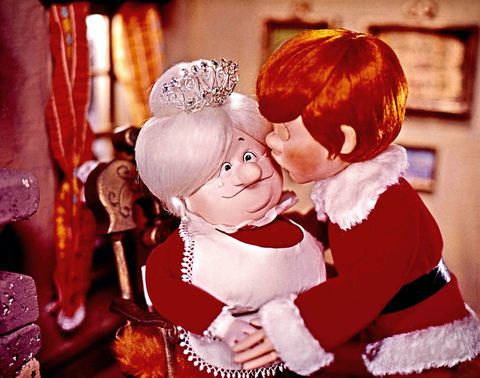Let’s admit it: As a society, we have been nowhere near skeptical enough about Santa Claus. For whatever reason, we have collectively agreed is acceptable—nay, encouraged—to force-feed to our children a lie. But myth or not, there seems to be an undeniable plot hole in the part of the legend where we all apparently agreed it was totally cool for an estranged old man to break into our house via chimney once a year.
Don’t get me wrong: I am in no way trying to take down Santa Claus. (Technically, I’m indebted to him for some decades of gifts, so that would also just not be strategic.) All I’m saying is context is key. And for a long while there seemed to be some significant inconsistencies about the man in red’s history. That is, until one television special came along to set the record straight 50 years ago.
When Rankin-Bass’s Santa Claus Is Comin’ to Town (SCICTT) first aired on CBS on December 14 of 1970, viewers were greeted by the face of a spry, blue-eyed mailman by the name of Special Delivery, “S.D.,” Kluger. Voiced by Fred Astaire, the stop-motion-animated puppet hopped out of his truck and began to read letters from his mailbag, filled with questions written by children around the world asking about the legend of Santa Claus. “I have all the answers,” S.D. Kluger assured, before breaking out into the film’s titular song. Now, a half century since its release, it’s high time we take a similar second look at the origins of this iconic Christmas special.
Much like the story of Santa Claus, SCICTT’s legacy has often been spread by word of mouth. And, just like the entourage that would help Kris Kringle reach his final form, there are plenty more contributors than meets the eye that helped SCICTT put “one foot in front of the other.” From the mind behind its storyline, to its “Animagic” team in Japan, to the wonder of catching it on television each year, there’s a bit of magic sprinkled throughout each step that has made the film as immortal as Santa Claus himself.
When it comes to SCICTT, perhaps the person closest to having “all the answers” like S.D. Kluger is Rick Goldschmidt. The official Rankin-Bass historian, Goldschmidt has come to serve as something of a final living link to the production company’s notable contributors, including founders Arthur Rankin, Jr. and Jules Bass. The footprint of Rankin-Bass is inextricable from pop culture. Tim Burton has cited Rankin-Bass as an inspiration for his own career, while shows like SNL, SpongeBob Squarepants, Community, and MadTV have all released their own Rankin-Bass parodies. Goldschmidt, who wrote about SCICTT in his book The Making of Santa Claus Is Comin’ to Town and The Daydreamer, says that the film came at a time when Rankin-Bass was “hitting their high-water mark” following the success of Rudolph the Red-Nosed Reindeer in 1964 and Frosty the Snowman in 1969. However, Goldschmidt says that what made the film truly timeless was the story at its core.
“I think it’s an important special because it does define Santa Claus for a lot of people,” says Goldschmidt, “And it’s all out of the mind of Romeo Muller.” Muller wrote many of Rankin-Bass’s greatest hits. And Goldschmidt says that, if Rankin hadn’t hired the screenwriter so many years ago, we might not be talking about the Rankin-Bass specials decades later.
The story follows Kris from his childhood as an adopted orphan of the elvish Kringle family, to his adult vocation of bestowing toys upon the children of the world. Entirely new characters are incorporated into the legend, like the evil town ruler Burgermeister Meisterburger, whose toy ban Kris must evade in order to deliver gifts to the children of Sombertown. Viewers also meet new dimensions of classic characters along the way, like Mrs. Claus, who is first presented as school teacher Miss Jessica, as well as Santa’s elves, seen as the Kringle family of toymakers.
These characters were brought to life by SCICTT’s star-studded cast: Fred Astaire, Keenan Wynn, Mickey Rooney, Paul Frees, and Robie Lester, among others. According to Goldschmidt, featuring a big-name actor on the bill became somewhat of a signature for Rankin-Bass after the studio was encouraged to swap in Burl Ives as Sam the Snowman in Rudolph at the last minute. But Rankin was no stranger to star power. Goldschmidt says that Rankin’s whole family was “in the business.” His mother was a singer; his father, an actor in Shirley Temple movies; his grandfather, the famous character actor, Harry Davenport. Goldschmidt said Rankin had an eye for talent, finding voice actors who would bring “personality to stop-motion animation.”
Along with the seasoned storytelling of Muller and a lively cast, SCICTT might have been a magnum opus of sorts for musical director Maury Laws. Goldschmidt says that the film featured one of Laws’s favorite pieces of his own work: the musical number “Christmas Carol” featured in Kris and Jessica’s wedding scene. Accompanied by fan favorites, “Put One Foot in Front of the Other,” and “Santa Claus Is Comin’ to Town,” and the oft-cut for time “My World is Beginning Today,” Goldschmidt notes the orchestrations filled with “bouncy glockenspiels” that have become a signature to Laws and Rankin-Bass. “You just hear it in the background and you think, ‘Man, that really is Christmas,’” Goldschmidt says.
This content is imported from YouTube. You may be able to find the same content in another format, or you may be able to find more information, at their web site.
You can’t talk about Rankin-Bass without discussing its animation process though—especially with a name like Animagic. If Romeo Muller is the heart of Rankin-Bass films, and Maury Laws is the beat, then the animators of Rankin-Bass truly are the brains. What many don’t know, though, is that all of the stop-motion animation process for Rankin-Bass films took place entirely in Japan.
The story goes that Rankin was invited by a delegate to visit studios in Japan, and was immediately struck by the caliber of their stop-motion animation. Multiple Japanese studios would be employed to contribute to each special—perhaps the most notable of them being Topcraft, now known today as Studio Ghibli (who produced many beloved animated series like the Oscar-winning Spirited Away). Tadahito “Tad” Mochinaga, whom Goldschmidt refers to as the Japanese “father of stop-motion,” served as the head animator for many Rankin-Bass specials until SCICTT, when his protégé Hiroshi Tabata is believed to have taken over. However, many of the exact roles held by these animators have been left to interpretation from the original films’ credits. While many studio owners received an honorary credit, others’ contributions like that of Tabata have been deduced from found photographs.
The talent and technicalities are important, but there’s really no better measurement of the film’s success than its programming history. “When they aired on television, and you had to see them that one time when there wasn’t any VCRs,” Goldschmidt says, “That was really special.” Even today, SCICTT is not readily available on most major streaming platforms—one of the major reasons why it still holds this allure of tradition today.
This significance is not lost on Sarah Lindmann, SVP of Content Planning and Strategy of Freeform, which has carried on its sister channel ABC’s legacy of airing the special as part of the “25 Days of Christmas” marathon. “Our partnership with ABC brings us one of the holiday season’s most seminal Christmas specials,” says Lindmann, calling the special a “roadmap” for negotiating an arrangement with CBS to also air Rudolph the Red-Nosed Reindeer and Frosty the Snowman. Lindmann says that the holiday season often attracts viewers hungry for “content that connects them with their families.” “Given all the challenges we face in 2020,” Lindmann says, “we’re proud and grateful to help feed that need.”
This content is imported from YouTube. You may be able to find the same content in another format, or you may be able to find more information, at their web site.
In a way, this cyclical need for stories that provide a bit of magic during darker days is timeless in itself. As the film comes to a close, a montage of cynical grown-ups plays, with a final furrow-browed businessman grumbling, “How can they talk about Santa Claus when there’s so much unhappiness in the world?” S.D. Kluger promptly replies, “Lots of unhappiness? Maybe so. But doesn’t Santa take a little bit of that unhappiness away?” Maybe this human suffering thing is more perennial than we remember. And maybe that’s what makes us, however defeated, digitized, or disillusioned, still check our TV guides to tune in to a 50-year-old stop-motion Christmas special. If that’s the case, then take it from S.D. Kluger himself: there will always be magic to revisit and reinvent, year after year. “Now that you know all about him,” he states before reboarding his mail truck, “you can be darned sure that, come snow or high water, Santa Claus Is Comin’ to Town.”
This content is created and maintained by a third party, and imported onto this page to help users provide their email addresses. You may be able to find more information about this and similar content at piano.io








